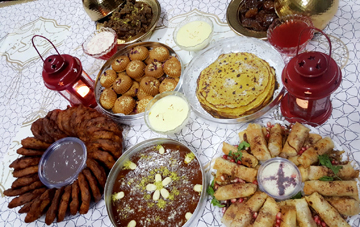ID :
492829
Sat, 05/19/2018 - 17:30
Auther :
Shortlink :
https://oananews.org//node/492829
The shortlink copeid
Bahrain Ramadan food: Feast for eyes, taste buds

Manama, May 19 (BNA): Ramadan is celebrated in Bahrain as a time of intense spirituality, piety and charity. It is also a month of stronger bonds between families and more vibrant social interaction.
The holy month is also an opportunity to relive enthusiastically deep-rooted traditions in which Bahrainis take so much pride and which they enjoy sharing with everyone, regardless of their backgrounds.
The culinary aspect of Ramadan remains a great feature of the month since food is regarded as self-rewards for successfully spending the day, from dawn till dusk, without food or drink.
Preparing the food for the breaking of the fast at Maghrib is an elaborate process that starts very early for the women of the family keen on showing off their skills even if it means braving multiple challenges.
A Bahraini Iftar is never complete without Thareed, considered as the undisputed star of the table, while the others dishes, although they are as tasty, are the supporting cast.
Beside its highly palatable taste, Thareed, the special combination of meat, vegetables, traditional bread and Arabic spices, is much appreciated as a healthy dish thanks to its carbohydrates, fibres, proteins and starches.
Those who are fasting also served the famous Harees, the dish of boiled, cracked or coarsely-ground wheat, mixed with meat, kebabs and appetizers.
Some families stop here and the men go to mosque to perform the Maghreb prayers, but others opt to pray together at home.
The main dish varies from family to family, but Bahrainis usually do not want to keep away from rice dishes. Bahrainis, like all Gulf nationals, live an endless love story with rice and they consume it in different shapes and tastes, depending on the cooking methods, the ingredients and the degree of spiciness. From Machboos to Biryani to Muhammar to Mandi to Ghouzi, they all hold much appeal and are omnipresent in the lives of Bahrainis during Ramadan and well beyond.
The main dish is followed by a variety of sweets that include the famous Bahraini halwa, khanfaroosh, the fried saffron and cardamom cakes, sago, the sweet pudding. A real feast for those with sweet teeth.
Time is then spent watching light television programmes and sharing anecdotes until the call to Isha prayers.
Men head to the mosque to perform the evening prayers and Tarweeh, the extra prayers particular to Ramadan to boost piety and supplications to God on this auspicious month.
While not much seems to be happening during the day when life adopts a slower rhythm with fewer working hours and less daytime activities, the evenings are particularly filled with all kinds of activities.
Following prayers, families exchange visits and get together and men tend to go to majlises, the deep-rooted tradition that all Bahrainis are keen on keeping. Some women take advantage of the cool weather and go to the traditional suqs, especially in Manama, where they engage actively and enthusiastically, in shopping. Shops, pleased with the presence of so many shoppers during Ramadan, stay open until 11 pm.
Another Ramadan feature is the Ghabga, the late dinner, hosted by some families and majlises. Although in hotels and restaurants that have embraced the habit, Ghabga is made up of the regular meals they serve, in the Bahraini traditions it is made up of white or red rice, and the much sought-after Safi (rabbitfish). .
The pre-dawn suhoor brings families together at home again. The food now tends to be light in order not to upset stomachs ahead of the fasting day.
The people who are sound asleep are woken up by the Musahhir, a man who walks in designated streets beating his drums to alert people that it is time to eat something before they abstain from food and drink until sunset.





